思路
搭建环境-->导入Mybatis-->编写代码-->测试
搭建数据库
CREATE DATEBASE `mybatis`;
USE `mybatis`;
CREATE TABLE `user`(
`id` INT(20) NOT NULL PRIMARY KEY,
`name` VARCHAR(30) DEFAULT NULL,
`pwd` VARCHAR(30) DEFAULT NULL
)ENGINE=INNODB DEFAULT CHARSET=utf8
INSERT INTO `user`(`id`,`name`,`pwd`) VALUES
(1,‘狂神‘,‘123456‘),
(2,‘张三‘,‘123456‘),
(3,‘李四‘,‘123890‘)
新建项目
新建一个普通的maven项目
删除src目录
导入maven依赖
<dependencies>
<dependency>
<groupId>mysql</groupId>
<artifactId>mysql-connector-java</artifactId>
<version>5.1.47</version>
</dependency>
<dependency>
<groupId>org.mybatis</groupId>
<artifactId>mybatis</artifactId>
<version>3.5.2</version>
</dependency>
<dependency>
<groupId>junit</groupId>
<artifactId>junit</artifactId>
<version>4.12</version>
</dependency>
</dependencies>
<?xml version="1.0" encoding="UTF-8" ?>
<!DOCTYPE configuration
PUBLIC "-//mybatis.org//DTD Config 3.0//EN"
"http://mybatis.org/dtd/mybatis-3-config.dtd">
<configuration>
<environments default="development">
<environment id="development">
<transactionManager type="JDBC"/>
<dataSource type="POOLED">
<property name="driver" value="com.mysql.jdbc.Driver"/>
<property name="url" value="jdbc:mysql://localhost:3306?useSSL=true&useUnicode=true&characterEncoding=UTF-8"/>
<property name="username" value="root"/>
<property name="password" value="123456"/>
</dataSource>
</environment>
</environments>
<mappers>
<mapper resource="org/mybatis/example/BlogMapper.xml"/>
</mappers>
</configuration>
package com.meng.utils;
import org.apache.ibatis.io.Resources;
import org.apache.ibatis.session.SqlSession;
import org.apache.ibatis.session.SqlSessionFactory;
import org.apache.ibatis.session.SqlSessionFactoryBuilder;
import java.io.IOException;
import java.io.InputStream;
public class MybatisUtils {
private static SqlSessionFactory sqlSessionFactory;
static {
try {
//使用Mybatis获取sqlSessionFactory对象
String resource = "mybatis-config.xml";
InputStream inputStream = Resources.getResourceAsStream(resource);
sqlSessionFactory = new SqlSessionFactoryBuilder().build(inputStream);
} catch (IOException e) {
e.printStackTrace();
}
}
public static SqlSession getSqlSession() {
return sqlSessionFactory.openSession();
}
}
public class User {
private int userId;
private String username;
private String password;
public User() {
}
public User(int userId, String username, String password) {
this.userId = userId;
this.username = username;
this.password = password;
}
public int getUserId() {
return userId;
}
public void setUserId(int userId) {
this.userId = userId;
}
public String getUsername() {
return username;
}
public void setUsername(String username) {
this.username = username;
}
public String getPassword() {
return password;
}
public void setPassword(String password) {
this.password = password;
}
@Override
public String toString() {
return "User{" +
"userId=" + userId +
", username=‘" + username + ‘\‘‘ +
", password=‘" + password + ‘\‘‘ +
‘}‘;
}
}
public interface UserDao {
List<User> getUserList();
}
<?xml version="1.0" encoding="UTF-8" ?>
<!DOCTYPE mapper
PUBLIC "-//mybatis.org//DTD Mapper 3.0//EN"
"http://mybatis.org/dtd/mybatis-3-mapper.dtd">
<!--namespace=绑定一个对应的Dao/Mapper接口-->
<mapper namespace="com.meng.dao.UserDao">
<select id="getUserList" resultType="com.meng.pojo.User">
select * from mybatis.user
</select>
</mapper>
MapperRegistry是什么
核心配置文件中注册mappers
@Test
public void test() {
//获得SqlSession对象
SqlSession sqlSession = MybatisUtils.getSqlSession();
//执行sql 方式一:getMapper
UserDao userDao = sqlSession.getMapper(UserDao.class);
List<User> userList = userDao.getUserList();
for (User user : userList) {
System.out.println(user);
}
//关闭SqlSession
sqlSession.close();
}
注意:Maven导出资源问题
<build>
<resources>
<resource>
<directory>src/main/resources</directory>
<includes>
<include>**/*.properties</include>
<include>**/*.xml</include>
</includes>
<filtering>true</filtering>
</resource>
<resource>
<directory>src/main/java</directory>
<includes>
<include>**/*.properties</include>
<include>**/*.xml</include>
</includes>
<filtering>true</filtering>
</resource>
</resources>
</build>
namespace
namespace中的包名要和Dao/mapper接口的包名一致
select
选择,查询语句
编写接口
//根据ID查询用户
User getUserById(int id);
编写对应的mapper中的sql语句
<select id="getUserById" resultType="com.meng.pojo.User" parameterType="int">
select * from blogdb.user_info where userId = #{id}
</select>
测试
public void getUserById() {
//获得SqlSession对象
SqlSession sqlSession = MybatisUtils.getSqlSession();
//执行sql 方式一:getMapper
UserMapper mapper = sqlSession.getMapper(UserMapper.class);
User user = mapper.getUserById(1);
System.out.println(user);
//关闭SqlSession
sqlSession.close();
}
Insert
<insert id="addUser" parameterType="com.meng.pojo.User">
insert into blogdb.user_info (userId, username, password) values (#{userId},#{username},#{password});
</insert>
update
<update id="updateUser" parameterType="com.meng.pojo.User">
update blogdb.user_info set username = #{username},password = #{password} where userId = #{userId};
</update>
Delete
<delete id="deleteUser" parameterType="int">
delete from blogdb.user_info where userId = #{userId};
</delete>
注意点
增删改需要提交事务
万能Map
假设我们的实体类,或者数据库中的表,字段或者参数过多,我们应当考虑使用Map!
User getUserById2(Map<String,Object> map);
<select id="getUserById2" parameterType="map" resultType="com.meng.pojo.User">
select * from mybatis.userId where id = #{helloId} and name = #{name};
</select>
@Test
public void getUserById2(){
SqlSession sqlSession = MybatisUtils.getSqlSession();
UserMapper mapper = sqlSession.getMapper(UserMapper.class);
Map<String,Object> map = new HashMap<String,Object>();
map.put("helloId",1);
mapper.addUser2(map);
sqlSession.close();
}
Map传递参数,直接在sql中取出key即可!【parameterType="map"】
对象传递参数,直接在sql中取出对象的属性即可!【paremeterType="Object"】
只有一个基本类型参数的情况下,可以直接在sql中取到!
多个参数用Map,或者注解!
Java代码执行的时候,传递通配符%%
List<User> userList = mapper.getUserLike("%李%");
在sql拼接中使用通配符!
select * from mybatis.user where name like "%"#{value}"%"
mybatis-config.xml
properties(属性)
settings(设置)
typeAliases(类型别名)
typeHandlers(类型处理器)
objectFactory(对象工厂)
plugins(插件)
environments(环境配置)
environment(环境变量)
transactionManager(事务管理器)
dataSource(数据源)
databaseIdProvider(数据库厂商标识)
mappers(映射器)
MyBatis 可以配置成适应多种环境
不过要记住:尽管可以配置多个环境,但每个 SqlSessionFactory 实例只能选择一种环境。
学会使用配置多套运行环境!
Mybatis默认的事务管理器就是JDBC,连接池:POOLED
我们可以通过properties属性来实现引用配置文件
这些属性可以在外部进行配置,并可以进行动态替换。你既可以在典型的 Java 属性文件中配置这些属性,也可以在 properties 元素的子元素中设置。【db.properties】
db.properties
driver=com.mysql.jdbc.Driver
url=jdbc:mysql://localhost:3306/blogdb?useSSL=false&useUnicode=true&characterEncoding=UTF-8
username=root
password=123456
在xml中,所有的标签都可以规定其顺序(properties、settings、typeAliases...)
<!--引入外部配置文件-->
<properties resource="db.properties"/>
<environments default="development">
<environment id="development">
<transactionManager type="JDBC"/>
<dataSource type="POOLED">
<property name="driver" value="${driver}"/>
<property name="url" value="${url}"/>
<property name="username" value="${username}"/>
<property name="password" value="${password}"/>
</dataSource>
</environment>
</environments>
类型别名可为 Java 类型设置一个缩写名字。 它仅用于 XML 配置,意在降低冗余的全限定类名书写
<typeAliases>
<typeAlias type="com.meng.pojo.User" alias="User"/>
</typeAliases>
也可以指定一个包名,Mybatis会在包名下面搜素需要的Java Bean,比如:
扫描实体类的包,他的默认别名就为这个类的类名首字母小写
<typeAliases>
<package name="com.meng.pojo"/>
</typeAliases>
在实体类少的时候,使用第一种方式(可以DIY别名)
如果实体类非常多,建议使用第二种,若有注解,则别名为其注解值
@Alias("author")
public class Author {
...
}


MapperRegistry:注册绑定我们的Mapper文件
方式一:
<mappers>
<mapper resource="com/meng/dao/UserMapper.xml"/>
</mappers>
方式二:使用class文件绑定注册
<mappers>
<mapper class="com.meng.dao.UserMapper"/>
</mappers>
注意点:
方式三:使用扫描包进行注入绑定
<mappers>
<package name="com.meng.dao"/>
</mappers>
注意点:
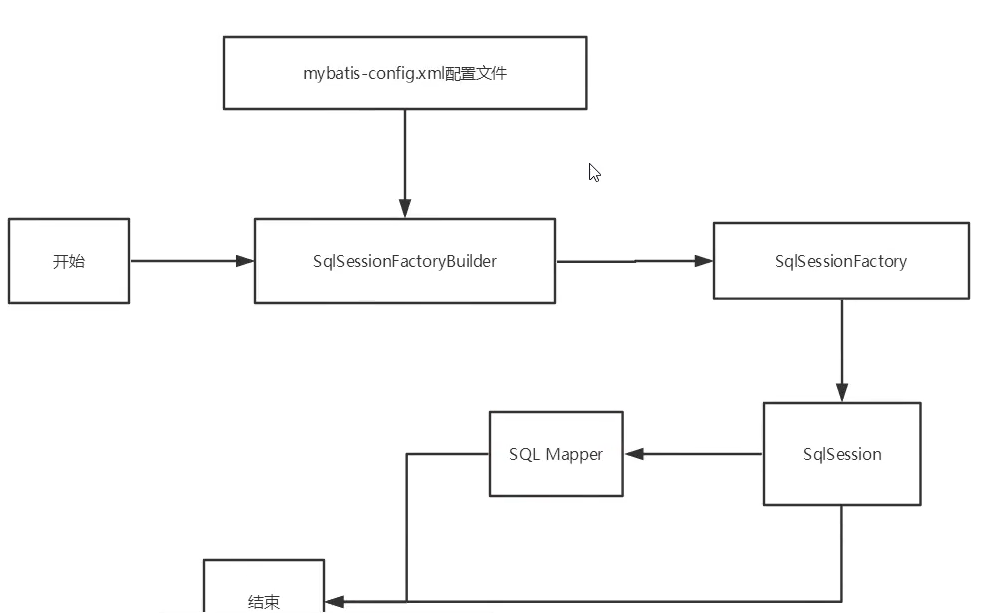
作用域和生命周期类别是至关重要的,因为错误的使用会导致非常严重的并发问题
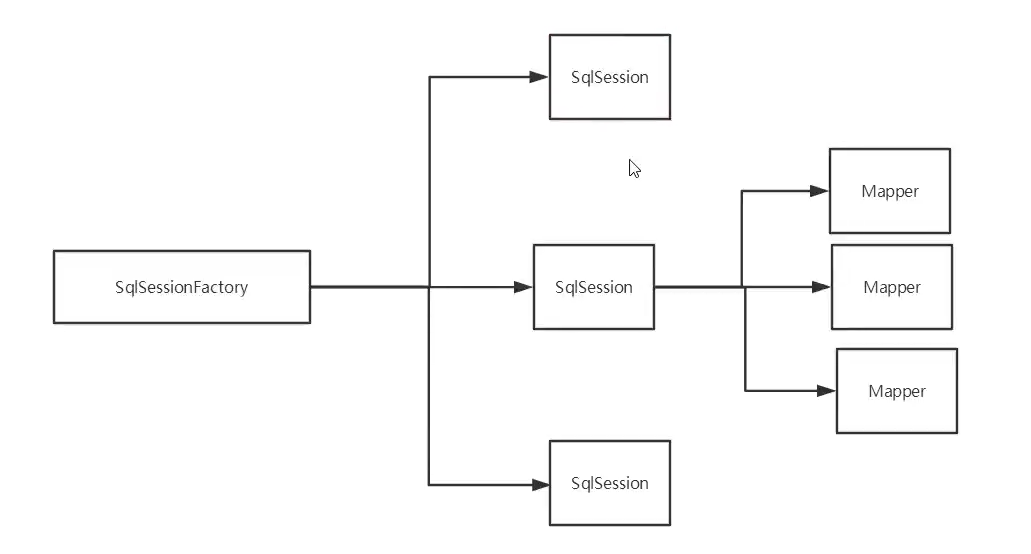
这里面的每个Mapper,就代表一个具体的业务
数据库中的字段
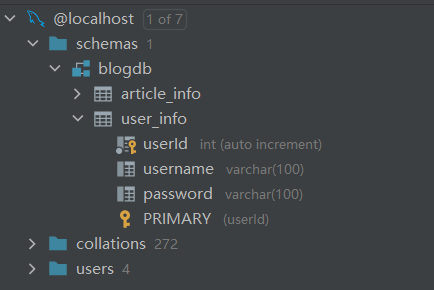
把实体类User中的password改为pwd
解决方法:
起别名
select userId,username,password as pwd from blogdb.user_info where id = #{id}
ResultMap
结果集映射
<resultMap id="UserMap" type="User">
<!--<result column="userId" property="userId"/>-->
<!--<result column="username" property="username"/>-->
<result column="password" property="pwd"/>
</resultMap>
<select id="getUserById" resultMap="UserMap">
select * from blogdb.user_info where id = #{id}
</select>
resultMap 元素是 MyBatis 中最重要最强大的元素resultMap 的优秀之处在于你完全可以不用显式地配置它们如果一个数据库操作出现异常,我们需要排错,日志就是最好的助手
曾经:sout、debug
现在:日志工厂!

在Mybatis中具体使用哪一个日志实现,在设置中设定
STDOUT_LOGGING标准日志输出
<settings>
<setting name="logImpl" value="STDOUT_LOGGING"/>
</settings>
在mybatis核心配置文件中,配置我们的日志!

先导包
<dependency>
<groupId>log4j</groupId>
<artifactId>log4j</artifactId>
<version>1.2.17</version>
</dependency>
log4j.properties
#将等级为DEBUG的日志信息输出到console和file这两个目的地,console和file的定义在下面的代码
log4j.rootLogger=DEBUG,console,file
#控制台输出的相关设置
log4j.appender.console = org.apache.log4j.ConsoleAppender
log4j.appender.console.Target = System.out
log4j.appender.console.Threshold=DEBUG
log4j.appender.console.layout = org.apache.log4j.PatternLayout
log4j.appender.console.layout.ConversionPattern=[%c]-%m%n
#文件输出的相关设置
log4j.appender.file = org.apache.log4j.RollingFileAppender
log4j.appender.file.File=./log/kuang.log
log4j.appender.file.MaxFileSize=10mb
log4j.appender.file.Threshold=DEBUG
log4j.appender.file.layout=org.apache.log4j.PatternLayout
log4j.appender.file.layout.ConversionPattern=[%p][%d{yy-MM-dd}][%c]%m%n
#日志输出级别
log4j.logger.org.mybatis=DEBUG
log4j.logger.java.sql=DEBUG
log4j.logger.java.sql.Statement=DEBUG
log4j.logger.java.sql.ResultSet=DEBUG
log4j.logger.java.sql.PreparedStatement=DEBUG
配置log4j为日志的实现
<settings>
<setting name="logImpl" value="LOG4J"/>
</settings>
Log4j的使用,直接测试运行刚才的查询
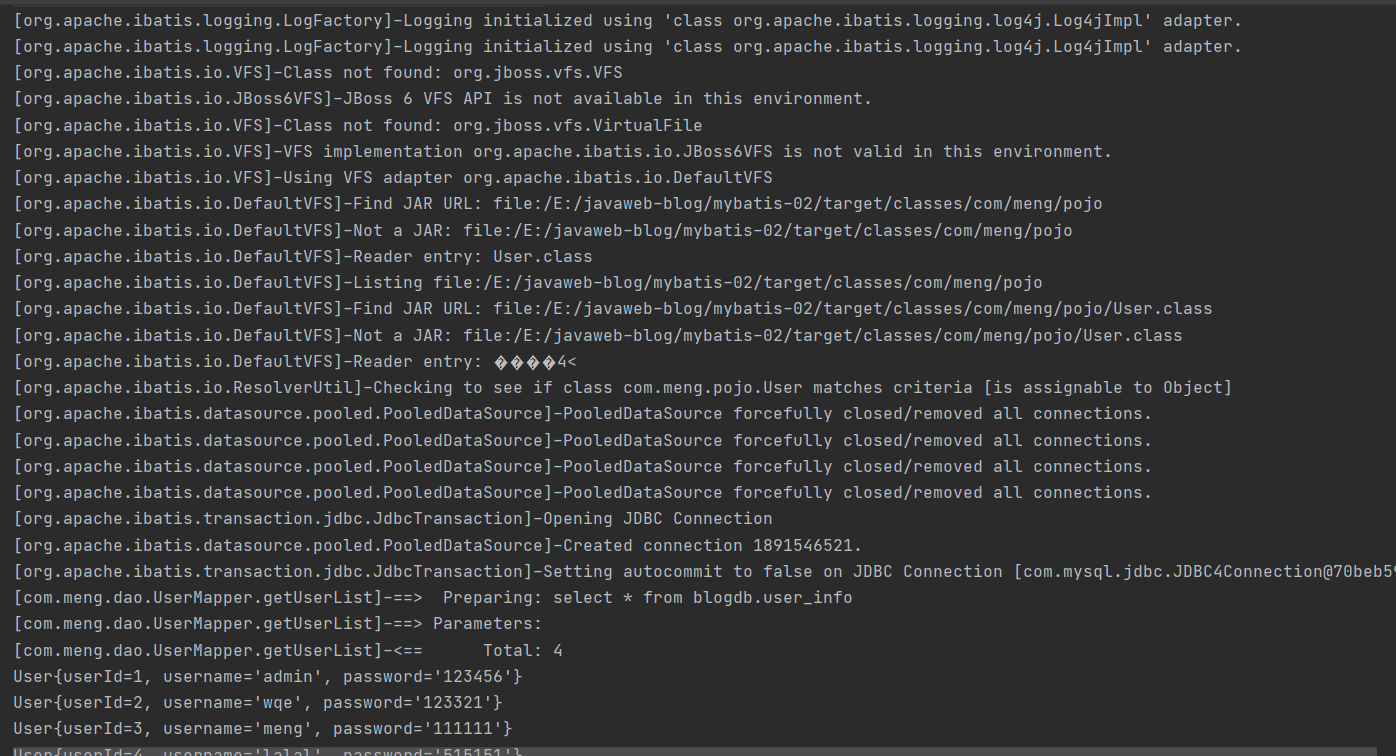

简单使用
在要使用Log4j的类中,导入包import org.apache.log4j.Logger
日志对象,参数为当前类的class
static Logger logger = Logger.getLogger(UserDaoTest.class);
日志级别
logger.info("info:进入了testLog4j");
logger.debug("debug:进入了testLog4j");
logger.error("error:进入了testLog4j");
为什么要分页?
使用Limit分页
select * from user_info limit 3; //0,3
使用Mybatis实现分页,核心SQL
接口
//分页
List<User> getUserByLimit(Map<String,Integer> map);
Mapper.xml
<select id="getUserByLimit" parameterType="map" resultType="user">
select * from blogdb.user_info limit #{startIndex},#{pageSize}
</select>
测试
@Test
public void getUserByLimit(){
SqlSession sqlSession = MybatisUtils.getSqlSession();
UserMapper mapper = sqlSession.getMapper(UserMapper.class);
HashMap<String, Integer> map = new HashMap<>();
map.put("startIndex",0);
map.put("pageSize",2);
List<User> userList = mapper.getUserByLimit(map);
for (User user : userList) {
System.out.println(user);
}
sqlSession.close();
}
不再使用SQL实现分页
接口
//分页2
List<User> getUserByRowBound();
mapper.xml
<select id="getUserByRowBounds" resultType="user">
select * from blogdb.user_info
</select>
测试
@Test
public void getUserByRowBounds(){
SqlSession sqlSession = MybatisUtils.getSqlSession();
RowBounds rowBounds = new RowBounds(1,2);
List<User> userList = sqlSession.selectList("com.meng.dao.UserMapper.getUserByRowBounds", null, rowBounds);
for (User user : userList) {
System.out.println(user);
}
sqlSession.close();
}
注解在接口上实现
@Select("select * from user_info")
List<User> getUsers();
需要在核心配置文件绑定接口
<mappers>
<mapper class="com.meng.dao.UserMapper"/>
</mappers>
测试
本质:反射机制实现
底层:动态代理
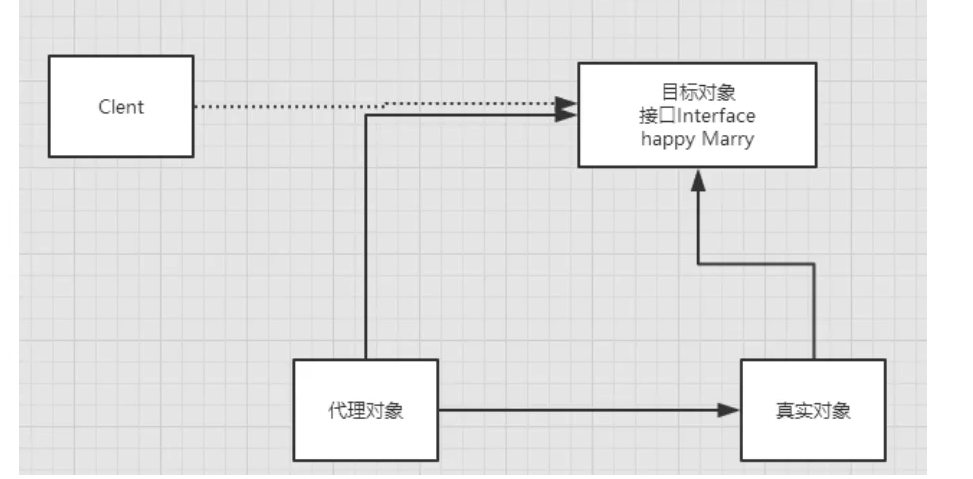

我们可以在工具类创建的时候实现自动提交事务
public static SqlSession getSqlSession() {
return sqlSessionFactory.openSession(true);
}
编写接口,增加注解
@Select("select * from user_info")
List<User> getUsers();
//方法存在多个参数,所有的参数前面必须加上 @Param("id")注解
@Select("select * from user_info where userId = #{id}")
User getUserByID(@Param("id") int id);
@Insert("insert into user_info(userId,username,password) values(#{userId},#{username},#{password})")
int addUser(User user);
测试类
@Test
public void test() {
SqlSession sqlSession = MybatisUtils.getSqlSession();
UserMapper mapper = sqlSession.getMapper(UserMapper.class);
List<User> users = mapper.getUsers();
for (User user : users) {
System.out.println(user);
}
sqlSession.close();
}
@Test
public void getUserByID() {
SqlSession sqlSession = MybatisUtils.getSqlSession();
UserMapper mapper = sqlSession.getMapper(UserMapper.class);
User userByID = mapper.getUserByID(1);
System.out.println(userByID);
sqlSession.close();
}
@Test
public void addUser(){
SqlSession sqlSession = MybatisUtils.getSqlSession();
UserMapper mapper = sqlSession.getMapper(UserMapper.class);
mapper.addUser(new User(5,"Hello","123123"));
sqlSession.close();
}
注意
我们必须要讲接口注册绑定到我们的核心配置文件中
关于@Param()注解
#{} ${}区别
使用步骤:
在IDEA中安装Lombok插件
在项目中导入lombok的jar包
在实体类上加注解即可
@Getter and @Setter
@FieldNameConstants
@ToString
@EqualsAndHashCode
@AllArgsConstructor, @RequiredArgsConstructor and @NoArgsConstructor
@Log, @Log4j, @Log4j2, @Slf4j, @XSlf4j, @CommonsLog, @JBossLog, @Flogger, @CustomLog
@Data
@Builder
@SuperBuilder
@Singular
@Delegate
@Value
@Accessors
@Wither
@With
@SneakyThrows
说明
@Data:无参构造,get、set、tostring、hashcode、equals
@AllArgsConstructo
@NoArgsConstructor
SQL:
CREATE TABLE `teacher` (
`id` INT(10) NOT NULL,
`name` VARCHAR(30) DEFAULT NULL,
PRIMARY KEY(`id`)
) ENGINE=INNODB DEFAULT CHARSET=utf8
CREATE TABLE `student` (
`id` INT(10) NOT NULL,
`name` VARCHAR(30) DEFAULT NULL,
`tid` INT(10) DEFAULT NULL,
PRIMARY KEY(`id`),
KEY `fktid`(`tid`),
CONSTRAINT `fktid` FOREIGN KEY(`tid`) REFERENCES `teacher`(`id`)
) ENGINE=INNODB DEFAULT CHARSET=utf8
INSERT INTO `student` (`id`, `name`, `tid`) VALUES (‘1‘, ‘小明‘, ‘1‘)
INSERT INTO `student` (`id`, `name`, `tid`) VALUES (‘2‘, ‘小红‘, ‘1‘)
INSERT INTO `student` (`id`, `name`, `tid`) VALUES (‘3‘, ‘小张‘, ‘1‘)
INSERT INTO `student` (`id`, `name`, `tid`) VALUES (‘4‘, ‘小李‘, ‘1‘)
INSERT INTO `student` (`id`, `name`, `tid`) VALUES (‘5‘, ‘小王‘, ‘1‘)
<!--
思路:
1.查询所有的学生信息
2.根据查询出来的学生的tid,寻找对应的老师!
-->
<select id="getStudent" resultMap="StudentTeacher">
select * from student;
</select>
<resultMap id="StudentTeacher" type="Student">
<result property="id" column="id"/>
<result property="name" column="name"/>
<!--复杂的属性,我们需要单独处理
对象:association
集合:collection
-->
<association property="teacher" column="tid" javaType="Teacher" select="getTeacher"/>
</resultMap>
<select id="getTeacher" resultType="Teacher">
select * from teacher where id = #{id}
</select>
<select id="getStudent2" resultMap="StudentTeacher2">
select s.id sid,s.name sname,t.name tname
from student s,teacher t
where s.tid = t.id;
</select>
<resultMap id="StudentTeacher2" type="Student">
<result property="id" column="sid"/>
<result property="name" column="sname"/>
<association property="teacher" javaType="Teacher">
<result property="name" column="tname"/>
</association>
</resultMap>
回顾Mysql多对一查询方式:
实体类
@Data
public class Student {
private int id;
private String name;
private int tid;
}
@Data
public class Teacher {
private int id;
private String name;
//一个老师拥有多个学生
private List<Student> students;
}
public interface TeacherMapper {
Teacher getTeacher(@Param("tid") int id);
}
<select id="getTeacher" resultMap="TeacherStudent">
select s.id sid,s.name sname,t.name tname,t.id tid
from student s,teacher t
where s.tid = t.id and t.id = #{tid}
</select>
<resultMap id="TeacherStudent" type="Teacher">
<result property="id" column="tid"/>
<result property="name" column="sname"/>
<!--复杂的属性,我们需要单独处理 对象:association 集合:collection
javaType="" 指定属性的类型!
集合中的泛型信息,我们使用ofType获取
-->
<collection property="students" ofType="Student">
<result property="id" column="sid"/>
<result property="name" column="sname"/>
<result property="tid" column="tid"/>
</collection>
</resultMap>
<select id="getTeacher2" resultMap="TeacherStudent2">
select * from teacher where id = #{tid}
</select>
<resultMap id="TeacherStudent2" type="Teacher">
<collection property="students" javaType="ArrayList" ofType="Student" select="getStudentByTeacherId" column="id"/>
</resultMap>
<select id="getStudentByTeacherId" resultType="Student">
select * from student where tid = #{tid}
</select>
注意点:
动态 SQL 是 MyBatis 的强大特性之一。如果你使用过 JDBC 或其它类似的框架,你应该能理解根据不同条件拼接 SQL 语句有多痛苦,例如拼接时要确保不能忘记添加必要的空格,还要注意去掉列表最后一个列名的逗号。利用动态 SQL,可以彻底摆脱这种痛苦。
if
choose (when, otherwise)
trim (where, set)
foreach
CREATE TABLE `blog`(
`id` VARCHAR(50) NOT NULL COMMENT ‘博客id‘,
`title` VARCHAR(100) NOT NULL COMMENT ‘博客标题‘,
`author` VARCHAR(30) NOT NULL COMMENT ‘博客作者‘,
`create_time` DATETIME NOT NULL COMMENT ‘创建时间‘,
`views` INT(30) NOT NULL COMMENT ‘浏览量‘
)ENGINE=INNODB DEFAULT CHARSET=utf8
创建一个基础工程
导包
编写配置文件
编写实体类
@Data
public class Blog {
private String id;
private String title;
private String author;
private Date createTime;
private int views;
}
编写实体类对应Mapper接口和Mapper.xml
<select id="queryBlogIF" parameterType="map" resultType="blog">
select * from blogdb.blog where 1=1
<if test="title != null">
and title = #{title}
</if>
<if test="author != null">
and author = #{author}
</if>
</select>
<select id="queryBlogChoose" parameterType="map" resultType="blog">
select * from blogdb.blog
<where>
<choose>
<when test="title != null">
title = #{title}
</when>
<when test="author != null">
and author = #{author}
</when>
<otherwise>
and views = #{views}
</otherwise>
</choose>
</where>
</select>
<select id="queryBlogIF" parameterType="map" resultType="blog">
select * from blogdb.blog
<where>
<if test="title != null">
and title = #{title}
</if>
<if test="author != null">
and author = #{author}
</if>
</where>
</select>
<update id="updateBlog" parameterType="map">
update blogdb.blog
<set>
<if test="title != null">
title = #{title},
</if>
<if test="author != null">
author = #{author}
</if>
</set>
where id = #{id}
</update>
<trim prefix="WHERE" prefixOverrides="AND |OR ">
...
</trim>
<trim prefix="SET" suffixOverrides=",">
...
</trim>
所谓的动态SQL,本质还是SQL语句,只是我们可以在SQL层面,去执行一个逻辑代码
有的时候,我们可能会将一些功能的部分抽取出来,方便复用!
使用SQL标签抽取公共的部分
<sql id="if-title-author">
<if test="title != null">
and title = #{title}
</if>
<if test="author != null">
and author = #{author}
</if>
</sql>
在需要使用的地方使用Include标签引用即可
<select id="queryBlogIF" parameterType="map" resultType="blog">
select * from blogdb.blog
<where>
<include refid="if-title-author"></include>
</where>
</select>
注意事项:
<!--
select * from blogdb.blog where 1=1 and (id=1 or id=2 or id=3)
我们现在传递一个万能的map,这map中可以存在一个集合
-->
<select id="queryBlogForeach" parameterType="map" resultType="blog">
select * from blogdb.blog
<where>
<foreach collection="ids" item="id" open="and (" close=")" separator="or">
id=#{id}
</foreach>
</where>
</select>
@Test
public void queryBlogForeach(){
SqlSession sqlSession = MybatisUtils.getSqlSession();
UserMapper mapper = sqlSession.getMapper(UserMapper.class);
HashMap map = new HashMap();
ArrayList<Integer> ids = new ArrayList<Integer>();
ids.add(1);
ids.add(2);
ids.add(3);
map.put("ids",ids);
List<Blog> blogs = mapper.queryBlogForeach(map);
for (Blog blog : blogs) {
System.out.println(blog);
}
sqlSession.close();
}
动态SQL就是在拼接SQL语句,我们只要保证SQL的正确性,按照SQL的格式,去排列组合就可以了
建议:
查询需要连接数据库,耗资源
一次查询的结果,给它暂存在一个可以直接取到的地方--> 内存
我们再次查询相同数据的时候,直接走缓存,就不用走数据库了

MyBatis系统中默认定义了两级缓存:一级缓存和二级缓存
测试步骤:
开启日志!
测试在一个Session中查询两次相同记录
查看日志输出

缓存失效的情况:
查询不同的东西
增删改操作,可能会改变原来的数据,所以必定会刷新缓存
查询不同的Mapper.xml
手动清理缓存
sqlSession.clearCache();
一级缓存是默认开启的,只在一次SqlSession中有效,也就是拿到连接到关闭连接这个区间段!
步骤:
开启全局缓存
<setting name="cacheEnabled" value="true"/>
在要使用二级缓存的Mapper中开启
<cache/>
也可以自定义一些参数
<cache eviction="FIFO"
flushInterval="60000"
size="512"
readOnly="true"/>
测试
@Test
public void test(){
SqlSession sqlSession = MybatisUtils.getSqlSession();
SqlSession sqlSession2 = MybatisUtils.getSqlSession();
UserMapper mapper = sqlSession.getMapper(UserMapper.class);
User user = mapper.queryUserById(1);
System.out.println(user);
sqlSession.close();
UserMapper mapper2 = sqlSession2.getMapper(UserMapper.class);
User user2 = mapper2.queryUserById(1);
System.out.println(user2);
sqlSession2.close();
System.out.println(user==user2);
}
问题:我们需要将实体类序列化!否则就会报错!
小结:
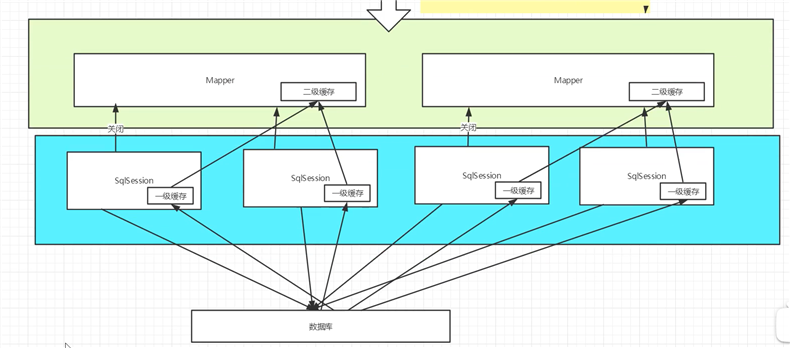
缓存顺序:
Encache是一种广泛使用的开源Java分布式缓存,主要面向通用缓存
要在程序中使用ehcache,先要导包!
<dependency>
<groupId>org.mybatis.caches</groupId>
<artifactId>mybatis-ehcache</artifactId>
<version>1.1.0</version>
</dependency>
在mapper中指定使用我们的ehcache缓存实现!
<cache type="org.mybatis.caches.ehcache.EhcacheCache"/>
ehcache.xml
<?xml version="1.0" encoding="UTF-8"?>
<ehcache xmlns:xsi="http://www.w3.org/2001/XMLSchema-instance"
xsi:noNamespaceSchemaLocation="http://ehcache.org/ehcache.xsd"
updateCheck="false">
<diskStore path="./tmpdir/Tmp_EhCache"/>
<defaultCache
eternal="false"
maxElementsInMemory="10000"
overflowToDisk="false"
diskPersistent="false"
timeToIdleSeconds="1800"
timeToLiveSeconds="259200"
memoryStoreEvictionPolicy="LRU"/>
<cache
name="cloud_user"
eternal="false"
maxElementsInMemory="5000"
overflowToDisk="false"
diskPersistent="false"
timeToIdleSeconds="1800"
timeToLiveSeconds="1800"
memoryStoreEvictionPolicy="LRU"/>
</ehcache>
原文:https://www.cnblogs.com/oucmly/p/14595491.html